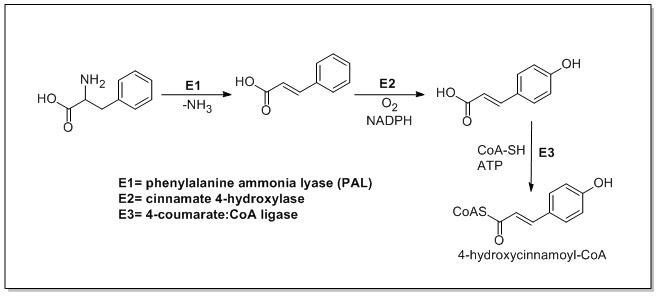The shikimate pathway is a seven step metabolic route used by bacteria, fungi, and plants for the biosythesis of aromatic amino acids (phenylalanine, tyrosine, and tryptophan).
Cinnamic and p-coumaric acids biosynthesis
In plants, the biosynthesis of all phenylpropanoids begins with the amino acids phenylalanine and tyrosine.
Phenylalanine ammonia-lyase (PAL, a.k.a. phenylalanine/tyrosine ammonia-lyase) is an enzyme responsible for the transformation of L-phenylalanine or tyrosine into trans-cinnamic acid or p-coumaric acid respectively and ammonia.
Trans-cinnamate 4-monooxygenase (cinnamate 4-hydroxylase) is the enzyme responsible for the transformation of trans-cinnamate into 4-hydroxycinnamate (p-coumaric acid). 4-Coumarate-CoA ligase is the enzyme responsible for the transformation of 4-coumarate (p-coumaric acid) into 4-coumaroyl-CoA.
Cinnamyl-alcohol dehydrogenase (CAD), an enzyme responsible for the transformation of cinnamyl alcohol into cinnamaldehydeSinapine esterase, an enzyme responsible for the transformation of sinapoylcholine into sinapate (sinapic acid) and cholineTrans-cinnamate 2-monooxygenase, an enzyme responsible for the transformation of trans-cinnamate (cinnamic acid) into 2-hydroxycinnamateCaffeate O-methyltransferase, an enzyme responsible for the transformation of caffeic acid into ferulic acidCaffeoyl-CoA O-methyltransferase, an enzyme responsible for the transformation of caffeoyl-CoA into feruloyl-CoA5-O-(4-coumaroyl)-D-quinate 3'-monooxygenase, an enzyme responsible for the transformation of trans-5-O-(4-coumaroyl)-D-quinate into trans-5-O-caffeoyl-D-quinateSinapoylglucose—choline O-sinapoyltransferase, an enzyme responsible for the transformation of 1-O-sinapoyl-beta-D-glucose into sinapoylcholine (sinapine)Sinapoylglucose—malate O-sinapoyltransferase, an enzyme responsible for the transformation of 1-O-sinapoyl-beta-D-glucose into sinapoyl-(S)-malate2-coumarate O-beta-glucosyltransferase, an enzyme responsible for the transformation of trans-2-hydroxycinnamate into trans-beta-D-glucosyl-2-hydroxycinnamateCinnamoyl-CoA reductase, an enzyme responsible for the production of cinnamoyl-CoA from cinnamaldehydeHydroxycinnamate 4-beta-glucosyltransferase, an enzyme responsible for the transformation of p-coumaric acid into 4-O-beta-D-glucosyl-4-hydroxycinnamateShikimate O-hydroxycinnamoyltransferase, an enzyme responsible for the transformation of 4-coumaroyl-CoA into 4-coumaroylshikimateQuinate O-hydroxycinnamoyltransferase, an enzyme responsible for the transformation of feruloyl-CoA into O-feruloylquinateSinapate 1-glucosyltransferase, an enzyme responsible for the transformation of sinapate (sinapic acid) into 1-sinapoyl-D-glucoseConiferyl-alcohol glucosyltransferase, an enzyme responsible for the transformation of coniferyl alcohol into coniferinConiferin beta-glucosidase, an enzyme responsible for the transformation of coniferin into coniferolPinosylvin synthase, an enzyme responsible for the formation of pinosylvin from cinnamoyl-CoATrihydroxystilbene synthase, an enzyme responsible for the production of resveratrol from 4-coumaroyl-CoAAn alternative bacterial ketosynthase-directed stibenoids biosynthesis pathway exists in Photorhabdus bacterial symbionts of Heterorhabditis nematodes, producing 3,5-dihydroxy-4-isopropyl-trans-stilbene for antibiotic purposes.
Scopoletin glucosyltransferase, an enzyme responsible for the transformation of scopoletin into scopolin4-Coumaroyl-CoA can be combined with malonyl-CoA to yield the true backbone of flavonoids, a group of compounds called chalconoids, which contain two phenyl rings. Naringenin-chalcone synthase is an enzyme that catalyzes the chemical reaction 3 malonyl-CoA + 4-coumaroyl-CoA → 4 CoA + naringenin chalcone + 3 CO2.
Conjugate ring-closure of chalcones results in the familiar form of flavonoids, the three-ringed structure of a flavone.
Caffeate 3,4-dioxygenase is an enzyme that uses 3,4-dihydroxy-trans-cinnamate (caffeic acid) and oxygen to produce 3-(2-carboxyethenyl)-cis,cis-muconate.
